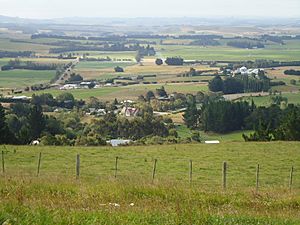Herbert, New Zealand facts for kids
Quick facts for kids
Herbert
|
|
|---|---|
|
Rural settlement
|
|

View of Herbert taken from Mount Charles
|
|
| Country | New Zealand |
| Region | Otago |
| Territorial authority | Waitaki District |
| Ward | Corriedale Ward |
| Electorates |
|
| Area | |
| • Total | 1.11 km2 (0.43 sq mi) |
| Population
(June 2023)
|
|
| • Total | 100 |
| • Density | 90/km2 (230/sq mi) |
| Local iwi | Ngāi Tahu |
Herbert is a small town in North Otago, New Zealand. It used to be called Otepopo. You can find it about 91 kilometers north of Dunedin. It's also about 22 kilometers south-west of Oamaru. The town sits right next to the Herbert Forest.
Herbert is a small collection of houses and three churches. They are all grouped around State Highway 1. There's also a service station that acts as the local post office. Two main businesses operate here. One is a helicopter base for farming, industry, and forestry. The other is a poultry farm. The land around Herbert is green and fertile, perfect for farming.
The poultry farm, Craigs Poultry, was even recognized for its environmental efforts in 2007. The main railway line, called the Main South Line, also goes through Herbert. There used to be a train station here, but it closed in 1980. Now, only the crossing loop remains. A short railway tunnel, called the Otepopo tunnel, is also nearby.
Contents
Otepopo School: A Look Back
The Otepopo School was once located about 300 meters from the town. It was a primary school for children aged 5 to about 13. After finishing there, students would go to Oamaru for more education. Sadly, Otepopo School closed in September 2010. This happened because fewer and fewer students were attending. In 2009, there were 22 students, but just before it closed, only 4 were left.
What's in a Name?
The New Zealand Ministry for Culture and Heritage has looked into the name Ōtepopo. They say it means "place of the decayed wood."
Exploring Nearby Waianakarua
About five kilometers south of Herbert is another farming area called Waianakarua. This place has a very old stone bridge. It's the oldest bridge still used on New Zealand's State Highway network. In 2004, this bridge was carefully taken apart, stone by stone. It was then rebuilt 2 meters wider. In 2005, it reopened for traffic.
Next to this bridge, you can see an old flourmill. Today, it's a place for meals and accommodation called The Mill House. About 3 kilometers upstream from the bridge, there's another historical flourmill site. You can also see the remains of a dam there. One of Waianakarua's most famous sights is "The Big Chicken." It's a tall, shaped bush (topiary) that looks like a giant chicken. Right beside it is a large Moeraki boulder that looks like an egg!
A Famous Connection
The son of Burt Munro lives in Waianakarua. Burt Munro was a famous New Zealand motorcycle racer. He was even featured in the movie The World's Fastest Indian, where he was played by Anthony Hopkins. Burt's son still has his father's famous motorcycle.
Fun Activities in the Area
If you love the outdoors, there are fun things to do in the Herbert and Waianakarua area. You can go pig hunting. There's also sea fishing and river fishing available.
People of Herbert
Herbert is a small rural settlement. As of June 2023, it had an estimated population of 100 people. The population has changed a bit over the years. In 2018, there were 96 people living there. This was a small decrease from 111 people in 2013 and 114 people in 2006.
Most people in Herbert are of European descent. A small number of people identify as Māori or Asian. When asked about religion, most people said they had no religion. Others identified as Christian or other religions.
Notable People from Herbert
- Annie Isabella James (1884–1965) was a Presbyterian medical missionary. She was known for her work helping people through medicine and her faith.
Images for kids


